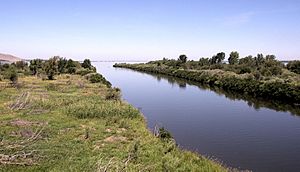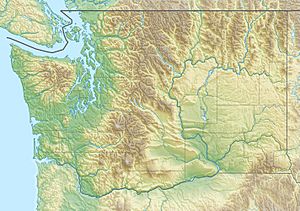Walla Walla River facts for kids
Quick facts for kids Walla Walla River |
|
|---|---|

Confluence of the Walla Walla and the Columbia rivers.
|
|
|
Mouth of the Walla Walla River in Washington
|
|
| Country | United States |
| State | Washington |
| Physical characteristics | |
| Main source | Blue Mountains near Milton–Freewater 45°53′54″N 118°18′28″W / 45.89833°N 118.30778°W |
| River mouth | Columbia River at Lake Wallula Wallula 46°3′58″N 118°55′3″W / 46.06611°N 118.91750°W |
| Length | 61 mi (98 km) |
| Basin features | |
| Basin size | 1,758 sq mi (4,550 km2) |
The Walla Walla River is a river in the United States. It flows through parts of Oregon and Washington. This river is a branch, or tributary, of the mighty Columbia River. It joins the Columbia River near a place called Wallula Gap in southeastern Washington. The area of land that drains into the Walla Walla River is about 1,758 square miles (4,550 km2).
Contents
Journey of the Walla Walla River
The Walla Walla River starts high up in the Blue Mountains of northeastern Oregon. It actually begins as two smaller rivers, the North Fork and the South Fork. These areas are covered in forests and have many trails for hiking and mountain biking.
Where the Forks Meet
The North and South Forks of the Walla Walla River come together east of a town called Milton–Freewater, Oregon. From there, the river flows through Milton–Freewater itself. People living along the river use its water to irrigate their farms. This means they take water from the river to help their crops grow.
Flowing Past Walla Walla City
The river then flows southwest of the city of Walla Walla. A smaller stream called Mill Creek, which runs through Walla Walla city, joins the Walla Walla River. This meeting point is near the Whitman Mission.
Joining the Touchet River
Further along, the Touchet River flows into the Walla Walla River near the town of Touchet, Washington. The amount of water flowing in the Walla Walla River just after the Touchet River joins it is usually about 1,212 cu ft/s (34.3 m3/s). The most water ever recorded flowing in the river was 20,300 cu ft/s (570 m3/s) in 1964.
Reaching the Columbia River
Finally, the Walla Walla River flows into the Columbia River. This happens about a mile south of the town of Wallula. This part of the Columbia River is called Wallula Lake. It's a large body of water created by the McNary Dam.
History of the Walla Walla River Area
The land around the Walla Walla River has a rich history. Long before European settlers arrived, the Walla Walla tribe lived in this region.
Early Explorers and Traders
- Lewis and Clark Expedition: The famous Lewis and Clark Expedition explored the western United States between 1804 and 1806. On their way back, they stopped at the mouth of the Walla Walla River. They stayed with the Walla Walla tribe for a while before continuing their journey.
- David Thompson: In 1811, a British explorer named David Thompson was the first European to travel the entire length of the Columbia River all the way to the Pacific Ocean.
- Fort Nez Percés: A fur trading post, first known as Fort Nez Percés, was built near where the Walla Walla River meets the Columbia. It operated from 1818 to 1857. This fort was important for trading animal furs. It was later called Fort Walla Walla. The fort was closed after the Hudson's Bay Company left the area.
- Whitman Mission: The Whitman Mission was set up in 1836. It was located close to the river, west of the modern city of Walla Walla.
Fish in the Walla Walla River
The Walla Walla River is home to many different kinds of fish. It's an important place for several species.
- Salmon and Trout: You can find spring Chinook salmon and summer steelhead here. Steelhead are a type of rainbow trout that spend part of their lives in the ocean. There are also bull trout.
- Sport Fishing: People enjoy fishing for steelhead in the river.
- Other Fish: In the summer, the river also has channel catfish and smallmouth bass.
Science and the River
Many groups are working to study and protect the Walla Walla River. These include government agencies and local environmental groups. They want to make sure the river has enough water and that the water is clean. This is important for both the fish, like salmon, and for farmers who need water for their crops.
Managing Water Resources
One big challenge is that a lot of water is taken from the river for irrigation. This can make the river's water levels low. Scientists are looking at ways to manage the water better. One idea is called Managed Aquifer Recharge. This means using extra water from the river during times when it's not needed for irrigation. This water is then used to refill underground water supplies. This helps keep the river healthy and provides water for everyone who needs it.
Images for kids
-
The Wallula Gap, where the Walla Walla enters the Columbia, as seen from near Fort Nez Percés, looking to the south





